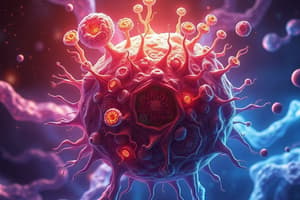Podcast
Questions and Answers
What is the process of maintaining a stable internal environment in an organism known as?
What is the process of maintaining a stable internal environment in an organism known as?
- homeostasis (correct)
- metabolism
- evolution
- development
Which element is essential for living organisms and needed in large amounts?
Which element is essential for living organisms and needed in large amounts?
- Copper (Cu)
- Aluminum (Al)
- Oxygen (O) (correct)
- Zinc (Zn)
What term describes atoms that have the same number of protons but different atomic weights?
What term describes atoms that have the same number of protons but different atomic weights?
- isotopes (correct)
- ions
- isomers
- neutrons
What type of bond is formed when atoms share a pair of electrons?
What type of bond is formed when atoms share a pair of electrons?
Which pair of atoms is most likely to form a non-polar covalent bond?
Which pair of atoms is most likely to form a non-polar covalent bond?
Which type of bond is generally considered the strongest?
Which type of bond is generally considered the strongest?
How many protons are in an atom of Bromine (Br)?
How many protons are in an atom of Bromine (Br)?
What occurs when two atoms have the same number of electrons?
What occurs when two atoms have the same number of electrons?
Which carbohydrate is primarily stored as energy in plant cells?
Which carbohydrate is primarily stored as energy in plant cells?
Which monosaccharide is a key component of nucleotides?
Which monosaccharide is a key component of nucleotides?
What is the primary role of glucose in the body?
What is the primary role of glucose in the body?
What is the main form of stored glucose in animal cells?
What is the main form of stored glucose in animal cells?
Which lipid is vital for the structure of cell membranes?
Which lipid is vital for the structure of cell membranes?
Which structure is a disaccharide?
Which structure is a disaccharide?
Which structure is recognized as a triglyceride?
Which structure is recognized as a triglyceride?
What would occur if the sequence of amino acids in a protein is changed?
What would occur if the sequence of amino acids in a protein is changed?
Which of the following is not a function of proteins?
Which of the following is not a function of proteins?
Which carbohydrate is a structural component of plant cell walls?
Which carbohydrate is a structural component of plant cell walls?
Which of the following best defines an electrolyte?
Which of the following best defines an electrolyte?
Which functional group is considered a weak acid?
Which functional group is considered a weak acid?
What is the effect of adding an acid to a solution?
What is the effect of adding an acid to a solution?
Which of the following molecules will dissolve but not dissociate in water?
Which of the following molecules will dissolve but not dissociate in water?
Which nucleic acid contains the information necessary to synthesize proteins in a cell?
Which nucleic acid contains the information necessary to synthesize proteins in a cell?
Which of the following best describes the structure of RNA?
Which of the following best describes the structure of RNA?
What is a primary characteristic of saturated fatty acids?
What is a primary characteristic of saturated fatty acids?
What molecular structure forms when glucose and fructose undergo a dehydration reaction?
What molecular structure forms when glucose and fructose undergo a dehydration reaction?
Which of the following accurately describes the behavior of C5H12 in water?
Which of the following accurately describes the behavior of C5H12 in water?
Which statement about anabolic reactions is true?
Which statement about anabolic reactions is true?
Which physical property of water contributes to its ability to stabilize temperature in the environment?
Which physical property of water contributes to its ability to stabilize temperature in the environment?
Which of the following describes a salt?
Which of the following describes a salt?
Which base is NOT included in DNA?
Which base is NOT included in DNA?
What is the basic structural unit of nucleic acids?
What is the basic structural unit of nucleic acids?
Flashcards
Homeostasis
Homeostasis
The process by which organisms maintain a stable internal environment, despite changes in the external environment.
Metabolism
Metabolism
The sum of all chemical reactions that occur within a living organism.
Atom
Atom
The smallest unit of matter that retains the properties of an element.
Molecule
Molecule
Signup and view all the flashcards
Isotopes
Isotopes
Signup and view all the flashcards
Covalent Bond
Covalent Bond
Signup and view all the flashcards
Ionic Bond
Ionic Bond
Signup and view all the flashcards
Hydrogen Bond
Hydrogen Bond
Signup and view all the flashcards
Cholesterol
Cholesterol
Signup and view all the flashcards
Glycogen
Glycogen
Signup and view all the flashcards
Starch
Starch
Signup and view all the flashcards
Glucose
Glucose
Signup and view all the flashcards
Ribose
Ribose
Signup and view all the flashcards
Fructose
Fructose
Signup and view all the flashcards
Galactose
Galactose
Signup and view all the flashcards
Lactose
Lactose
Signup and view all the flashcards
Sucrose
Sucrose
Signup and view all the flashcards
Triglyceride
Triglyceride
Signup and view all the flashcards
Isomers
Isomers
Signup and view all the flashcards
High Specific Heat
High Specific Heat
Signup and view all the flashcards
Electrolyte
Electrolyte
Signup and view all the flashcards
Nonelectrolyte
Nonelectrolyte
Signup and view all the flashcards
Buffers
Buffers
Signup and view all the flashcards
Adding acid
Adding acid
Signup and view all the flashcards
Enzymes and activation energy
Enzymes and activation energy
Signup and view all the flashcards
Anabolic reactions
Anabolic reactions
Signup and view all the flashcards
Phosphoryl group
Phosphoryl group
Signup and view all the flashcards
DNA structure
DNA structure
Signup and view all the flashcards
Saturated fatty acids
Saturated fatty acids
Signup and view all the flashcards
RNA structure
RNA structure
Signup and view all the flashcards
Nucleotide
Nucleotide
Signup and view all the flashcards
DNA
DNA
Signup and view all the flashcards
Study Notes
Maintaining Internal Environments
- Maintaining a stable internal environment is called homeostasis
- Maintaining a stable body temperature is homeostasis
Levels of Biological Organization (Least to Most Complex)
- Atom
- Molecule
- Organelle
- Cell
- Tissue
- Organ
- Organ System
- Organism
Essential Elements
- Oxygen (O) is needed in large amounts
Atomic Structure of Bromine (Br)
- Protons: 35
- Neutrons: 45
- Electrons: 35 in a neutral atom
- Bromine forms a negatively charged ion (-).
Isotopes
- Atoms of the same element with different numbers of neutrons are isotopes.
Types of Chemical Bonds
- Atoms share pairs of electrons in covalent bonds.
- Covalent bonds are stronger than ionic and hydrogen bonds.
Types of Covalent Bonds
- Non-polar covalent bonds form between atoms with similar electronegativities (e.g., C-H)
- Polar covalent bonds form between atoms with different electronegativities (e.g., O-H, O-C, and H-N)
Strongest Bond
- Non-polar covalent bonds are the strongest
Isomers
- Isomers are molecules with the same molecular formula but different arrangements of atoms.
Properties of Water
- High specific heat, forming hydrogen bonds with each other, high heat of vaporization, good solvent
Specific Heat of Water
- It takes a lot of energy to change the temperature of water.
Solubility in Water
- Some compounds dissolve but do not dissociate in water (e.g., C6H12O6, C6H14).
- Electrolytes (ionic molecules) dissolve and dissociate into ions in water. (e.g. NaCl).
Acids and Bases
- Acids decrease pH, while bases increase pH.
Buffers
- Buffers resist changes in pH.
Enzymes
- Enzymes decrease the activation energy needed for a reaction to occur.
Anabolic Reactions
- Anabolic reactions require energy, join molecules, and do not break molecules apart.
Functional Groups
- Carboxyl group is a weak acid.
Identifying Molecules by Structure
- Images provided show examples of monosaccharides, disaccharides, fatty acids.
Nucleic Acids
- DNA is a double-stranded molecule made up of nucleotides and held together by hydrogen bonds.
- RNA is a single-stranded molecule made up of nucleotides.
Essential Nutrients/Macromolecules
- Unsaturated fatty acids cannot be synthesized by the body
- Saturated fatty acids have single bonds between carbons.
- Sterols are important for cell membranes, steroid hormones, and other functions.
Carbohydrates
- Glucose is a monosaccharide used as an energy source.
- Sucrose is a disaccharide formed by glucose and fructose.
- Starch/glycogen are polysaccharides (energy storage)
- Ribose is a monosaccharide found in nucleotides.
- Cellulose is a polysaccharide found in plant cell walls.
Other Key Molecules
- ATP is a modified nucleotide providing energy.
Studying That Suits You
Use AI to generate personalized quizzes and flashcards to suit your learning preferences.
Description
Explore the concepts of homeostasis, levels of biological organization, and the essential elements critical for life. This quiz delves into atomic structures, isotopes, and various types of chemical bonds, enhancing your understanding of fundamental biology principles.



